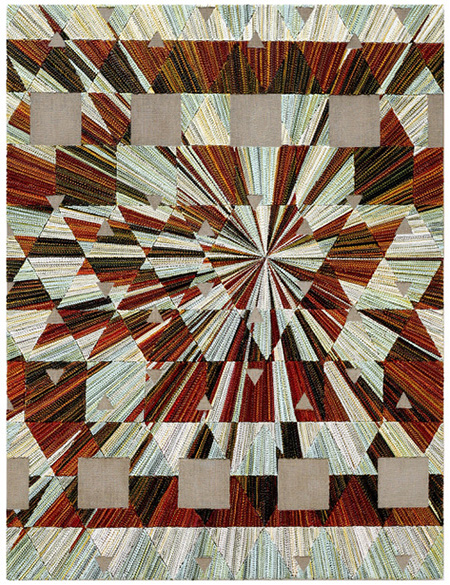
Continuing through March 9, 2019
“Passementerie,” the title of this exhibition of new paintings by Toronto-based Sasha Pierce, refers to the tassels, fringes, and other decorative trims found on textiles or clothing. To create her paintings, Pierce builds compositions of geometric patterning from multicolored linear strands that could be mistaken for passementerie, only they are made from oil paint rather than thread. Using a labor-intensive process of her own invention, Pierce mixes paint on a palette, transfers it to plastic bags, squeezes it like ultrathin toothpaste onto canvas, and nudges it into position with a ruler. Although her imagery evolves organically, each work derives from a tessellation, a mathematical model of interlocking geometric shapes. Although completely contemporary in concept and execution, Pierce’s paintings share a common bond with Old Master trompe l’oeil paintings and the Surrealist works of Dali and Magritte, in that they are sumptuous brainteasers, delightfully loaded with visual deceptions or contradictions.
Moving beyond the question of “Is it cloth or is it paint,” Pierce confounds the initial paradox by leaving portions of each canvas unpainted, thereby using the canvas weave as a compositional and illusionistic element. In some cases she paints in black. Perceptual playfulness is also evident in the abundance of contrasts between flatness and illusion, stasis and movement, and raw and finished surfaces within individual works. In “[3(3)4(2); (33434)3],” strands of paint emanating from a vortex at the upper center lead our eyes deep into the space, while an overall pattern of squares and triangles moves us back to the surface. In “Crown II” and “[3(6); 3(3).4(2)]2,” shifting perspectives beautifully approximate the experience of looking into a hall of mirrors, where perceptions of space are distorted by the interactions of reflections and refractions. Another standout is “Starry Night II,” where Pierce has created a balanced equilibrium between painted and unpainted areas, using a latticework structure that simulates the effect of looking upwards through a glass dome. Abstract and architectural in structure, the painting feels like it anchors us in the space from which we view it.
